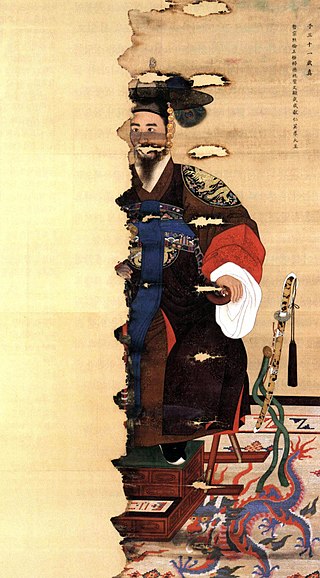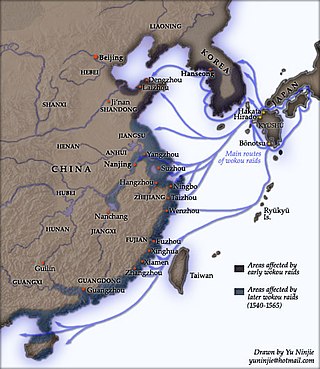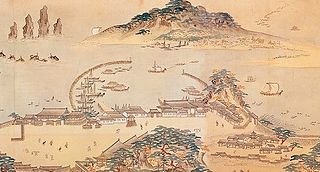- 1 2 3 Wakō Encyclopaedia Britannica
- ↑ Batten Bruce. "Gateway to Japan" 2006
- ↑ Kwan-wai So. Japanese piracy in Ming China, during the 16th century. Michigan State University Press, 1975. chapter 2.
- ↑ Wang Xiangrong, "Periodizing the History of Sino-Japanese Relations" Sino-Japanese Studies v. 2 (1980), 31
- ↑ Sansom, George (1961). A History of Japan, 1334–1615. Stanford University Press. p. 265. ISBN 978-0804705257.
- ↑ Prof. Wang Yong, "Realistic and Fantastic Images of 'Dwarf Pirates': The Evolution of Ming Dynasty Perceptions of the Japanese." In Prof. Joshua A. Fogel, ed., Sagacious Monks and Bloodthirsty Warriors: Chinese Views of Japan in the Ming-Qing Period (EastBridge, 2002), 17–41
- ↑ Prof. Douglas R. Howland. Borders of Chinese Civilization: Geography and History at Empire's End (Duke University Press Books, 1996), p. 22
- ↑ Wang Yong, Image of Japan in Chinese history. Section 2 of Chapter 6. Nousangyoson bunka Kyōkai, 2000, ISBN 9784540001710
- ↑ Hiroki Ōta, Naval timbers of Goryeo. In connection with the Yuan Dynasty's invasion of Japan. pp.2-20. Geirinkai, 1988, NAID 40000975703
- ↑ Ōta, Kōki, Wakō: nihon afure katsudōshi (Bungeisha, 2004), p. 98 (太田弘毅『倭寇: 日本あふれ活動史』.) (in Japanese)
- ↑ Kawazoe, Shōji, Taigai kankei no shiteki tenkai (Bunken shuppan, 1996) p. 167 (川添昭二「対外関係の史的展開」) (in Japanese).
- ↑ Yosaburō Takekoshi. The economic aspects of the history of the civilization of Japan. 1967. p. 344.
- 1 2 Park, Seong-rae (2005). Science and Technology in Korean History: Excursions, Innovations, and Issues. Jain Pub Co. p. 85.
- ↑ 세종실록 4권, 세종 1년 6월 20일 National Institute of Korean History.
- ↑ 세종실록 4권, 세종 1년 6월 29일 National Institute of Korean History.
- ↑ 세종실록 4권, 세종 1년 7월 3일 National Institute of Korean History.
- ↑ 세종실록 4권, 세종 1년 7월 9일 National Institute of Korean History.
- ↑ 세종실록 4권, 세종 1년 7월 10일 National Institute of Korean History.
- ↑ 宗氏家譜, 対州編年略.
應永二十六年己亥六月廿日、朝鮮將李從茂率戰艦二百二十七艘、卒一萬七千二百八十五人、到對馬州與良郡淺海浦。州兵拒之海濱不利。朝鮮兵到仁位郡、分道下陸、竟進屯糠獄。貞茂率州兵、到糠嶽下。侵矢石攻之。連戰數日、七月初一日、與左軍朴松戰大破之。朝鮮兵狼狽走海濱乘船、貞茂使海人放火。以燒賊船。齋藤、立石等發兵撃之。賊兵大潰而還。我兵戰死者百二十三人。斬賊二千五百餘級。 - ↑ Ōei Invasion. Encyclopedia Nipponica.
- ↑ Yang Shuiming (杨水明), 六鳌古城:倾听历史的涛声 Archived 2012-04-26 at the Wayback Machine (The old Liu'ao Fortress: listening to the waves of history) (in Chinese).
- ↑ History of Ming, Volume 322, "Biography Section 210: Japan (3)" (明史·卷三百二十二~卷三百二十三": Year Jiajing 26 1547) (in Chinese)
- ↑ Reid, Anthony (2010). Elusive pirates, pervasive smugglers violence and clandestine trade in the greater china seas (PDF). Hong Kong: Hong Kong University Press. p. 18.
- ↑ "1587, a year of no significance : The Ming dynasty in decline". 7 March 1981.
- 1 2 Mann, C. C. (2011). 1493: Uncovering the new world Columbus created . Vintage.
- ↑ Kwan-wai So. Japanese piracy in Ming China, during the 16th century. Michigan State University Press, 1975. ch. 3.
- ↑ "Bio General Qi JiGuang". www.plumpub.com.
- ↑ General Archive of the Indies, Philippines, file 29, bunch 3, number 62. Letter from Juan Bautista Román to the Viceroy of México, 25 June 1582
- ↑ General Archive of the Indies, Philippines, file 6, bunch 2, number 60. Letter from the Governor of the Philippines to the Viceroy of México, 20 July 1583
- ↑ General Archive of the Indies, Philippines, file 74, bunch 1, number 24. Letter from Bishop of the Philippines to the King of Spain, 18 January 1583
- ↑ General Archive of the Indies, Council of the Indies, 339,L.1,F.286V-287R. Order to send men to the Philippines from Mexico, 14 June 1583
- ↑ Kenji, Igawa (2010). Antony, Robert (ed.). at the Crossroads: Limahon and Wako in Sixteenth-Century Philippines, in Elusive Pirates, Persavie Smugglers. Hong Kong: Hong Kong University Press. pp. 78–82. ISBN 9789888028115.
- ↑ Chen Maoheng (1957), Mingdai wokou kaolue [A brief history of Japanese pirates during Ming dynasty]. Beijing (originally published in 1934), cited in Higgins (1981), p. 29
- ↑ Tanaka, Takeo, Wakō to kangōbōeki (Shibundo, 1966) (田中健夫『倭寇と勘合貿易』) (in Japanese)
- ↑ 世宗 114卷 28年 (1446 丙寅) 10月 28日 (壬戌) (in Traditional Chinese).
臣聞前朝之季, 倭寇興行, 民不聊生, 然其間倭人不過一二, 而本國之民, 假著倭服, 成黨作亂.. 救弊之要, 莫切於號牌。
- 1 2 P'ar-hyŏn Chang (장팔현), PhD. "Were the Wokou made up mostly of Goryeo and Choson Koreans then?". Chungbuk National University.
그러나 우리 측 사료인 '고려사'에는 단 3건의 가왜(假倭)기록이 있을 뿐이다. 1223년부터 1392년까지 169년간 총 529회의 침입에 겨우 3번의 '가왜' 기록이 있을 뿐인데, 이를 보고 왜구의 주체를 고려인으로 봄은 어불성설이고 침소봉대를 해도 너무 지나치다고 볼 수 있다. '조선왕조실록'에도 왜구침구 기사가 무려 312건이 나오는데 이 기사 어디에도 조선인이 왜구라는 말은 없다.
- 1 2 3 Murai, Shōsuke, Chūsei wajinden (Iwanami, 1993) (村井章介『中世倭人伝』) (in Japanese)
- ↑ Hiroshi Mitani. "A Protonation-state and its 'Unforgettable Other'." in Helen Hardacre, ed., New directions in the study of Meiji Japan. Brill. p. 295
- ↑ Tōgō, Takashi; Ueda, Shin, illustr. (2007). Etoki zōhyō ashigaru tachi no tatakai (in Japanese). Kodansha. pp. 48–51.
東郷隆, 上田信 『【絵解き】雑兵足軽たちの戦い』
{{cite book}}: CS1 maint: multiple names: authors list (link) - ↑ Barbara Seyock. "Pirates and Traders". In Trade and Transfer Across the East Asian "Mediterranean", Otto Harrassowitz Verlag, 2005. p. 95.
Related Research Articles

Sejong, personal name Yi To, commonly known as Sejong the Great, was the fourth monarch of the Joseon dynasty of Korea. He is regarded as one of the greatest rulers in Korean history, and is remembered as the inventor of Hangul, the native alphabet of the Korean language.

Cheoljong, personal name Yi Won-beom, later Yi Byeon, was the 25th monarch of the Joseon dynasty of Korea. After King Heonjong died without any descendants in 1849, Queen Sunwon chose Cheoljong, aged 19, to ascend to the throne, adopting him as the heir of her late husband, King Sunjo.

Taejo, personal name Yi Sŏng-gye, later Yi Tan, was the founder and first monarch of the Joseon dynasty of Korea. After overthrowing the Goryeo dynasty, he ascended to the throne in 1392 and abdicated six years later during a strife between his sons. He was honored as Emperor Go following the establishment of the Korean Empire.

Tsushima Island is an island of the Japanese archipelago situated in-between the Tsushima Strait and Korea Strait, approximately halfway between Kyushu and the Korean Peninsula. The main island of Tsushima, once a single island, was divided into two in 1671 by the Ōfunakoshiseto canal and into three in 1900 by the Manzekiseto canal. These canals were driven through isthmuses in the center of the island, forming "North Tsushima Island" (Kamino-shima) and "South Tsushima Island" (Shimono-shima). Tsushima also incorporates over 100 smaller islands, many tiny. The name Tsushima generally refers to all the islands of the Tsushima archipelago collectively. Administratively, Tsushima Island is in Nagasaki Prefecture.
The Ōei Invasion, also known as the Gihae Expedition, was a 1419 Joseon invasion of Tsushima Island, which is located in the middle of the Tsushima Strait between the Korean Peninsula and Kyushu.
The Gyehae Treaty was signed in 1443 between the Joseon dynasty and Sō Sadamori as a means of controlling Japanese piracy and legitimizing trade between Tsushima island and three Korean ports. It is also called Kakitsu Treaty; 1443 is the third year of the Kakitsu era in the Japanese calendar.
Wang Zhi, art name Wufeng (五峰), was a Chinese pirate lord of the 16th century, one of the main figures among the wokou pirates prevalent during the reign of the Jiajing Emperor. Originally a salt merchant, Wang Zhi turned to smuggling during the Ming dynasty's period of maritime prohibitions banning all private overseas trade, and eventually became the head of a pirate syndicate stretching across the East and South China Seas, from Japan to Thailand. Through his clandestine trade, he is credited for spreading European firearms throughout East Asia, and for his role in leading the first Europeans to reach Japan in 1543.

The naval history of Korea dates back thousands of years since the prehistoric times when simple fishing ships were used. Military naval history dates back to the Three Kingdoms period and Unified Silla dynasties of Korea in the 7th century. Because of the constant coastal attacks by the Wa Japanese and other barbarian tribes, Korean shipbuilding excelled to counter these threats as a result. During the Unified Silla period, Jang Bogo, a merchant, rose as an admiral and created the first maritime trading within East Asian countries. During the Goryeo dynasty, sturdy wooden ships were built and used to fight pirates. Korean shipbuilding again excelled during the Imjin war, when Admiral Yi defeated the advancing Japanese fleets.

An Yong-bok was a Korean fisherman in 17th century of Joseon Dynasty famous for his travels to Japan. His activities were instrumental in determining fishery rights in the waters of Ulleungdo and the Liancourt Rocks, two islands in the East Sea.
Yi Ye was a nobleman and Korean civil minister and diplomat during the early Joseon Dynasty. He served as an ambassador to the Japanese Ashikaga shogunate and founded the Hakseong Yi clan. He is notable for having negotiated the release of 667 Korean captives from wokou pirates in over 15 diplomatic missions, and for facilitating bi-national cooperation with Japan.
Yŏ Ŭison was a Korean civil minister (munsin) and diplomat from the Hamyang Yŏ clan during the early Joseon period. Yŏ served as the first governor (moksa) of Jeju Island and a Jeonseo (minister). He also was sent to Japan as a diplomat representing Joseon.
Japanese missions to Joseon represent a crucial aspect of the international relations of mutual Joseon-Japan contacts and communication. The bilateral exchanges were intermittent.
Queen Cheorin, of the Andong Kim clan, was queen consort of Joseon by marriage to King Cheoljong. She was known as Queen Dowager Myeongsun (명순대비) after the death of her husband and during King Gojong's reign. When King Gojong proclaimed the Korean Empire, the Queen was posthumously given the title of Cheorin, the Symbolic Empress.

The Jiajing wokou raids caused extensive damage to the coast of China in the 16th century, during the reign of the Jiajing Emperor in the Ming dynasty. The term "wokou" originally referred to Japanese pirates who crossed the sea and raided Korea and China; however, by the mid-Ming, the wokou consisted of multinational crewmen that included the Japanese and the Portuguese, but a great majority of them were Chinese instead. Mid-Ming wokou activity began to pose a serious problem in the 1540s, reached its peak in 1555, and subsided by 1567, with the extent of the destruction spreading across the coastal regions of Jiangnan, Zhejiang, Fujian, and Guangdong.
Princess Gyeonghwa was a Goryeo Royal Princess as the third and youngest daughter of King Gongyang and Royal Consort Sun. Following the establishment of the new Joseon dynasty, Princess Gyeonghwa became the last Goryeo Royal Princess.
King Yangheon, born Wang Do, was a Goryeo royal prince as the first and oldest son of King Munjong and Consort Ingyeong who would become the grandfather of the future Queen Janggyeong, Queen Uijeong, and Queen Seonjeong. He was known as Marquess Joseon and Duke Joseon during his lifetime.

The Military of Goryeo was the primary military force of the Goryeo dynasty. During the Later Three Kingdoms period, Wang Kŏn overthrew the Taebong ruler, Kung Ye, and renamed it Goryeo after the Goguryeo dynasty. He led the kingdom's armies and navies against Silla and Later Baekje and unified the peninsula. Goryeo was able to mobilize sizable military might during times of war.

Waegwan, also known as wakan, were Japanese ethnic enclaves (nihonmachi) primarily located in southern coastal cities of the Koreanic state Joseon. They existed from around the 15th century until the late 19th century.
Yi Yang-mu was a Goryeo general and nephew of Yi Ui-bang, father of Queen Sapyeong. As part of the Jeonju Yi clan, he was the 5th generation ancestor of Yi Sŏng-gye, founder of the Joseon Dynasty.
References
Primary sources:
- Hŭi-gyŏng Song, Shōsuke Murai. Rōshōdō Nihon kōroku : Chōsen shisetsu no mita chūsei Nihon (老松堂日本行錄 : 朝鮮使節の見た中世日本) Iwanami Shoten, Tōkyō, 1987. ISBN 978-4-00-334541-2
- Zheng Ruohui, Zhouhai Tubian (籌海図編)
Secondary sources:
- Boxer, C.R. "Piracy in the South China Sea", History Today , XXX, 12 (December), pp. 40–44.
- Boxer, Charles Ralph; Pereira, Galeote; Cruz, Gaspar da; Rada, Martín de (1953), South China in the sixteenth century: being the narratives of Galeote Pereira, Fr. Gaspar da Cruz, O.P. [and] Fr. Martín de Rada, O.E.S.A. (1550–1575), Issue 106 of Works issued by the Hakluyt Society, Printed for the Hakluyt Society (Includes an English translation of Galeote Pereira's report and Gaspar da Cruz' book, with C.R. Boxer's comments)
- Elisonas, Jurgis (1991). "6 – The inseparable trinity: Japan's relations with China and Korea". In Hall, John Whitney; McClain, James L. (eds.). The Cambridge History of Japan. Vol. 4. Cambridge Eng. New York: Cambridge University Press. pp. 235–300. ISBN 9780521223553.
- Higgins, Roland L. (1981). Piracy and coastal defense in the Ming period, government response to coastal disturbances, 1523–1549 (Ph.D.). University of Minnesota.
- So, Kwan-wai. Japanese Piracy in Ming China During the sixteenth Century. Michigan State University Press, East Lansing, 1975. ISBN 0-87013-179-6
- Turnbull, Stephen "Samurai: The World of the Warrior" Osprey Publishing, Oxford, 2003, pp. 155–57. ISBN 1-84176-740-9
Mann, C. C. (2011). 1493: Uncovering the new world Columbus created. Vintage.161-163
External links
- "Tribute and Trade", KoreanHistoryProject.org
| Wokou | |
|---|---|
 An 18th-century Chinese painting depicting a naval battle between wokou pirates and the Chinese |
